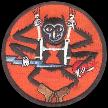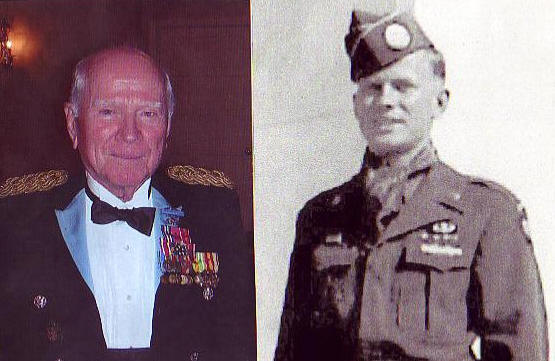
Guinn E Unger
Many thank you to Guinn for accepting to answer my questions and for me spent a little time. Thank you so much Colonel!

Guinn E Unger
Many thank you to Guinn for accepting to answer my questions and for me spent a little time. Thank you so much Colonel!

Guinn E. Unger was born on November 19, 1925 in Gerrardstown in West Virginia. His
father, Ernest Unger, was working as a foreman in the Muselman Company. Her
mother, Sybil Unger was a housewife as
most women at the same time, she raised the
children. Guinn has two brothers and one sister. Thanks
to his work, his family did not suffer from the Great Depression.Guinn therefore
experienced a very happy childhood.
On 10 August 1943, after finishing his studies at the
Biglerville High School, Guinn volunteered to serve his country.
“I was a member of the 345th Infantry or the 87th Inf Div, Fort Jackson, SC. Then, in July 1944. I wanted to be in an elite unit.”
He went to Fort Benning Airborne School. He
completed 4 weeks of basic training of parachute and then 9 weeks of training at
the Airborne Communications School.
“I had never been in an airplane before my first jump. The same was true for
most of my classmates.”
Although the training was hard, Guinn, 18 years old, became airborne.
In January 1945, Guinn left the
United States for the European theater.
“I boarded on a big ocean liner. 15,000 troops on board, Army and Air Force together. Sailed from New York to Scottland, Short trip, no convoy. Then by train to the south of England. By boat to France and by train and truck to Belgium.”
Guinn Unger was assigned to Headquarters Company, 507th Parachute Infantry
Regiment, 17th Airborne Division.
At this point, the 17th Airborne came out of
heavy fighting in the
Ardennes. The 507th PIR was in need of reinforcement. When
he arrived, the unit had left for the front area of rest and preparation in
Chalons sur Marne. From
12 February, the first new recruits arrived at last. Men
in key positions and specialists were still needed.
“I was in the Communications Platoon.”
Guinn spent the next months to prepare with his new comrades for the big jump in
Germany: Operation
Varsity.
24 March 1945, the big day. At 7:30 am, the first
aircraft taking off.
Approaching the drop zone, the Guinn’s plane
was taken under fire from the flak.
“We had 135 planes for the jump. I was in number 134. The first 45 were the best. The Germans were not ready. By the third wave, they were.”
“The Prostetant Chaplain and his assistant were on the plane, but both were killed on the drop zone. As were four others.”
Guinn jumped the 12th on a stick 18. He remembers his jump:
“Someone landed on my canopy but was able to get off. I got my rifle out and was ready to land when someone swung into me and we landed together. All this in about 30-40 seconds. ”
Guinn landed too far east compared to the initial DZ. He went to Northwestern. He was left alone for several hours.
“I was a Message Center clerk, but we had heavy losses in Radio Operators, so I was made a Radio Operator as soon as I joined my unit.”
Guinn retains some memory of what happened just after landing:
“The landing, seeing the Chaplain and his assistant dead after only a few minutes on the ground and running into a German back up Squad while I was starting to walk.”
In the days that followed the first and only combat jump of the 17th Airborne,
the unit progressed towards Muenster. Day
progressed, the war neared the end.
After Muenster, the 507th took Essen. Guinn
will remember the discovery of a Polish’s mass grave near the city. He
was joined by Col. Edson Raff at that time.
He was
his radio operator in Essen.
At the end of the war, the 507th remained in
Essen as occupation troops.
In late June 1945 when the 17th Airborne
stationed in
France, it is designated to accommodate veterans who return home to be
demobilized. To
do this, an exchange of soldiers would be flown.
Guinn Unger will be part of the troops which will
join the 82nd Airborne Division who serves as occupation troops in
Berlin.
He was assigned to the 2nd Battalion HQ 505th PIR. But
Guinn did not return with the 82nd Airborne:
“When the 82nd went back to the states, I was sent to the 508th in Frankfurt, the only Airborne unit in Europe. I didn't get back to the states until May of 1946. I was discharge on 3 May and went home that day.”
In September 1946, taking advantage of the GI Bill, Guinn resumes his studies.
First he went to Temple University and then finished it
at Gettysburg College. He finished in 1949.
In 1946 he met his wife whom he married Aug. 31, 1947. They had 3 son. Guinn and his wife also have seven grandchildren, five boys and two girls. Unfortunately, cancer took away his wife October 31, 2001.
With his degree, Guinn was also commissioned by the army, becoming 2nd
Lieutenant in the infantry. He
made a military career that ended in 1974 when he retired with the rank of
Colonel.
He was an officer in the 1st Infantry Division then
occupying in Bamberg in Germany and stationed at Heidelberg from 1964 to 1965.
Then in Aschaffenberg with the 3rd Inf. Div. in 1966 to 1967. During
that time, he was an officer in the 2nd Battalion, 7th
Mechanical Infantry Battalion and later the 4th Battalion, 64th
Armor.
Finally, he participated in the Vietnam War:
“For the first six months, I was the Division G4 of the First Cav. Div. The Div was an Air Mobile Div. We had 535 helicopters. The second six months I was the Commander of the 1st Bn., 7th Cav, in the Division. Although that was the name, it was in fact an Infantry Batallion. (Air Mobile) It was the assignment that I wanted. I was in Vietnam from July 68 to July 69. That was the peak of the action for us Americans.”
Then he was assistant dean of administration in the School of Medicine at the
University of Louisville for 21 years when he took his retirement in 1995.
Guinn regularly attends meetings of the former
507th PIR which he is Honorary Colonel. But
as veterans of the 1st Cavalry Division, his unit during
Vietnam.
In WWII he was awarded the Bronze Star and Combat
Infantry Badge and his period as an officer he was awarded two Silver Star and
Combat Infantry Badge another.
Today, Guinn Unger lives in
San Antonio, Texas.